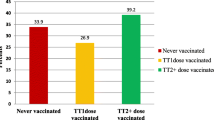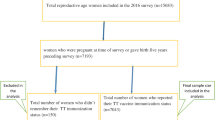Abstract
Although the effectiveness of tetanus toxoid (TT) immunization during pregnancy in preventing maternal and neonatal tetanus is well established, in many developing countries, TT immunization programs are underutilized. The objective of this study was to examine factors associated with sufficient TT immunization among postpartum women in Kenya. Population based secondary data analysis was conducted using de-identified data from the 2008–2009 Kenyan Demographic and Health Survey (KDHS) for 1,370 female participants who had a live birth during or within 12 months of the cross-sectional survey. Chi-square test and independent sample t test were conducted to assess bivariate associations and a multivariable logistic regression analysis was conducted to examine associations before and after adjustment for demographic, socioeconomic, cultural, and access to care factors. The main factors contributing to having been sufficiently immunized against tetanus were lower birth order, higher household wealth index, women’s employment, making joint health-related decisions with a partner, and higher number of antenatal care visits. Implications for health care providers and other professionals involved in development of strategies and interventions aimed at improving immunization rates are discussed.
Similar content being viewed by others
References
Cook, T. M., Protheroe, R. T., & Handel, J. M. (2001). Tetanus: A review of the literature. British Journal of Anaesthesia, 87(3), 477–487.
Sheffield, J. S., & Ramin, S. (2004). Tetanus in pregnancy. American Journal of Perinatology, 21(4), 173–182.
World Health Organization, United Nations Children’s Fund & United Nations Population Fund. (2000). Maternal and neonatal tetanus elimination by 2005. Strategies for achieving and maintaining elimination. Geneva: WHO.
Vandelaer, J., Partridge, J., & Suvedi, B. K. (2009). Process of neonatal tetanus elimination in Nepal. Journal of Public Health, 31(4), 561–565.
World Health Organization. (2011). Health topics: Tetanus. Geneva: WHO.
Zarocostas, J. (2008). UNICEF aims to eliminate tetanus in mothers and babies by 2012. BMJ, 337, a1987.
Roper, M., Vandelaer, J., & Gasse, F. (2007). Maternal and neonatal tetanus. Lancet, 370, 1947–1959.
Prusa, A. R., Wiedermann, U., Kasper, D. C., Hayde, M., Helmer, H., Pollak, A., et al. (2011). Tetanus immunity in neonates in a developed country. Neonatology, 100(1), 52–56.
World Health Organization. (2012). WHO/UNICEF review of national immunization coverage, 1997–2010. Geneva: WHO.
Mwaniki, M. K., Gatakaa, H. W., Mturi, F. N., Chesaro, C. R., Chuma, J. M., Peshu, N. M., et al. (2010). An increase in the burden of neonatal admissions to a rural district hospital in Kenya over 19 years. BMC Public Health, 10, 591.
Blencowe, H., Cousens, S., Mullany, L. C., Lee, A. C. C., Kerber, K., Wall, S., et al. (2011). Clean birth and postnatal care practices to reduce neonatal deaths from sepsis and tetanus: A systematic review and Delphi estimation of mortality effect. BMC Public Health, 11(Suppl 3), S11–S11.
Demicheli, V., Barale, A., & Rivetti, A. (2005). Vaccines for women to prevent neonatal tetanus. Cochrane Database of Systematic Reviews (Online), 4(4), CD002959.
Blencowe, H., Lawn, J., Vandelaer, J., Roper, M., & Cousens, S. (2010). Tetanus toxoid immunization to reduce mortality from neonatal tetanus. International Journal of Epidemiology, 39, i102–i109.
Perry, H., Weierbach, R., El-Arifeen, S., & Hossain, I. (1998). A comprehensive assessment of the quality of immunization services in one major area of Dhaka city, Bangladesh. Tropical Medicine & International Health, 3(12), 981–992.
Hasnain, S., & Sheikh, N. H. (2007). Causes of low tetanus toxoid vaccination coverage in pregnant women in Lahore district, Pakistan. Eastern Mediterranean Health Journal, 13(5), 1142–1152.
Basher, M. S. (2010). Knowledge and practice about TT vaccination among undergraduate female medical students. Mymensingh Medical Journal, 19(4), 520–523.
Rahman, M. (2009). Tetanus toxoid vaccination coverage and differential between urban and rural areas of Bangladesh. East African Journal of Public Health, 6(1), 26–31.
Kidane, T. (2004). Factors influencing TT immunization coverage and protection at birth coverage in Tselemti district, Ethiopia. Ethiopian Journal of Health Development, 18(3), 153–158.
Kenya National Bureau of Statistics and ICF Macro. (2010). Kenya demographic and health survey 2008–09. Calverton, ML: Kenya National Bureau of Statistics and ICF Macro.
World Health Organization. (2002). Core information for the development of immunization policy. 2002 update. Geneva: WHO. Retrieved July 5, 2012 from https://extranet.who.int/aim_elearning/ru/vaccines/hepb/pdf/www557.pdf.
Thind, A. (2005). Determinants of tetanus toxoid immunization in pregnancy in rural Bihar. Tropical Doctor, 35(2), 75–77.
Bassani, D. G., Surkan, P. J., & Olinto, M. T. (2009). Inadequate use of prenatal services among Brazilian women: The role of maternal characteristics. International Perspectives on Sexual & Reproductive Health, 35(1), 15–20.
Habibov, N. N. (2011). On the socio-economic determinants of antenatal care utilization in Azerbaijan: Evidence and policy implications for reforms. Health Economics, Policy and Law, 6(2), 175–203.
Navaneetham, K., & Dharmalingam, A. (2002). Utilization of maternal health care services in southern India. Social Science and Medicine, 55(10), 1849–1869.
Maral, I., Baykan, Z., Aksakal, F. N., Kayikcioglu, F., & Bumin, M. A. (2001). Tetanus immunization in pregnant women: Evaluation of maternal tetanus vaccination status and factors affecting rate of vaccination coverage. Public Health, 115(5), 359.
Hulsey, T. M., Laken, M., Miller, V., & Ager, J. (2000). The influence of attitudes about unintended pregnancy on use of prenatal and postpartum care. Journal of Perinatology, 20(8), 513–519.
Tinson, J. (2000). Is there a ‘typical’ consumer of obstetric services? Royal Society for the Promotion of Health, 120(3), 158–163.
Kabakian-Khasholian, T., & Campbell, O. M. R. (2005). A simple way to increase service use: Triggers of women’s uptake of postpartum services. BJOG, 112(9), 1315–1321.
Amin, R., Shah, N. M., & Becker, S. (2010). Socioeconomic factors differentiating maternal and child health-seeking behavior in rural Bangladesh: A cross-sectional analysis. International Journal for Equity in Health, 9, 9–19.
Islam, M. R., & Odland, J. O. (2011). Determinants of antenatal and postnatal care visits among indigenous people in Bangladesh: A study of the Mru community. Rural and Remote Health, 11(2), 1672.
Simkhada, B., van Teijlingen, E., Porter, M., & Simkhada, P. (2008). Factors affecting the utilization of antenatal care in developing countries: Systematic review of the literature. Journal of Advanced Nursing, 61(3), 244–260.
Zafar, A. A., Ehiri, J. E., & Anyanwu, E. C. (2003). Use of antenatal services in Kampung District, Cambodia. The Scientific World Journal, 3, 1081–1092.
Erci, B. (2003). Barriers to utilization of prenatal care services in Turkey. Journal of Nursing Scholarship, 35(3), 269–273.
Kabir, M., Iliyasu, Z., Abubakar, I. S., & Sani, A. A. (2005). Determinants of utilization of antenatal care services in Kumbotso village, northern Nigeria. Tropical Doctor, 35(2), 110–111.
Magadi, M. A., & Madise, N. J. (2000). Frequency and timing of antenatal care in Kenya: Explaining the variations between women of. Social Science and Medicine, 51(4), 551–561.
Rutenberg, N., & Watkins, S. C. (1997). The buzz outside the clinics: Conversations and contraception in Nyanza province. Kenya. Studies in Family Planning, 28(4), 290–307.
Stephenson, R., Baschieri, A., Clements, S., Hennink, M., & Madise, N. (2006). Contextual influences on the use of health facilities for childbirth in Africa. American Journal of Public Health, 96(1), 84–93.
Nwogu, E. C. (2009). Utilization of maternity care in Nigeria. Global Journal of Pure and Applied Sciences, 15(3), 439–447.
Javaid, B. K., Bari, A., Naz, S., & Ahmed, U. (2009). Immunization rates in children in relation to maternal education. Pakistan Paediatric Journal, 33(2), 79–85.
Ibor, U. W., Anjorin, O. A., Ita, A. E., Otu, M. A., & Bassey, T. I. (2011). Utilization of antenatal care in Ibadan north local government area, Oyo state, Nigeria. Trends in Medical Research, 6(4), 273–280.
Acknowledgments
The authors would like to thank ICF International for providing access to the 2008–2009 Kenya Demographic and Health Survey. The authors also thank Dr. Xiaoyun Pan for her valuable comments on the manuscript.
Author information
Authors and Affiliations
Corresponding author
Rights and permissions
About this article
Cite this article
Haile, Z.T., Chertok, I.R.A. & Teweldeberhan, A.K. Determinants of Utilization of Sufficient Tetanus Toxoid Immunization During Pregnancy: Evidence from the Kenya Demographic and Health Survey, 2008–2009. J Community Health 38, 492–499 (2013). https://doi.org/10.1007/s10900-012-9638-9
Published:
Issue Date:
DOI: https://doi.org/10.1007/s10900-012-9638-9




